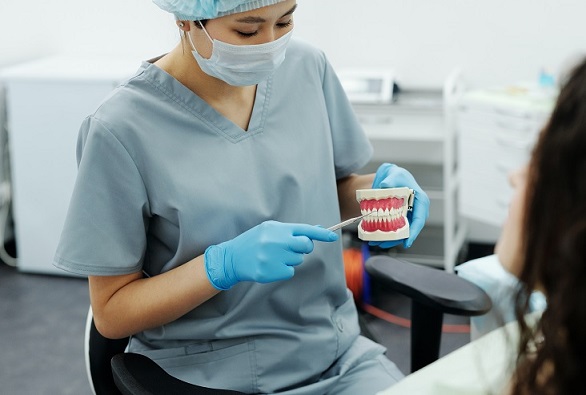The Future of Dentistry: How Technology is Changing Dental Care

The Rise of Digital Dentistry
Digital dentistry has significantly revolutionised dental treatment as technology continues to innovate. This unique method benefits patients by transforming their treatment experience and inspiring experts to explore new alternatives.
Based on modern developments, digital dentistry is a significant factor behind the dental revolution. The tools range from computer-aided manufacturing and computer-aided construction to intraoral scanning and customised printing. The rapid development of digital dentistry has led to better access to care and faster clinic procedures.
On the other hand, customised teeth can be created quickly using detailed digital imprints. CAD/CAM software recommends the best restorative solution for each person. This allows patients to view the digital impression from the comfort of their homes and increases work efficiency in the dental clinic.
Digital interactions and patient relationships have also been revolutionised by integrative technology. Read more to learn how technology impacts dental care – the future of dentistry.
Advancements in Dental Imaging and Diagnostics
Dental treatment has evolved with advancements in imaging and diagnostics. 3D scans and traditional X-rays are now used to provide better diagnosis and personalised treatment planning. The widespread use of 3D dental scans marks a significant change in the field.
Cone beam computed tomography is a revolutionary technology that provides dentists with fully three-dimensional oral anatomy. These realistic images make more accurate treatment planning possible, particularly for intricate dental implant and orthodontic treatments. Furthermore, intraoral cameras have changed how dental practitioners assess and record patients’ oral health.
Using digital impressions for personalised restorations such as crowns, bridges, and aligners is a ground-breaking innovation. This method ensures greater accuracy and eliminates the need for impression trays. While several restorations necessitate precise impressions, other procedures can be quickly completed.
Dental care providers are expected to implement new advances. As dentistry embraces change, patients can anticipate a superior, more precise, customised examination and treatment process. Professional dentists can make better-informed decisions and provide tailored solutions leveraging modern imaging and diagnostic technologies.
Robotic and Computer-Assisted Dental Procedures
Robotic technology has transformed dentistry, introducing predictable, efficient, and comfortable experiences. Dental robotics, for example, uses complicated software and technology to enable specialists to perform delicate implant preparation, crown work, and orthodontic modifications more precisely than ever before. Programming systems to execute specific tasks typically outperform manual techniques.

Computer-aided manufacturing has also changed dentistry remarkably. Through 3D scanning and printing, dentists assisted by CAD/CAM technology can craft bespoke restorations, prosthetics, and aligners in a single visit, eliminating multiple appointments and ensuring overall patient satisfaction. These automated innovations are still progressing rapidly and are likely to develop into even more sophisticated solutions in the future, continuing to transform dental care.
The Role of AI and Machine Learning in Dental Care
Artificial intelligence and machine learning are drastically transforming dentistry. They empower dentists to establish highly accurate diagnoses and treatment plans customised precisely to patients’ needs, improving treatment outcomes.
By utilising predictive analytics, the computer can analyse vast amounts of patient data, such as medical history, dental history, and X-rays, to identify trends and patient risk factors that may indicate probable future oral health problems.
This allows the dentist to predict potential issues in advance with utmost confidence. Additionally, developing a decision-support system aids the dentist in determining the best course of treatment based on the patient’s symptoms and indicators with unwavering precision.
Hence, AI is improving dental care. Treatments become more efficient and accurate by automating administrative tasks and using surgical equipment precisely. The rapid adoption of AI in dentistry should motivate us to embrace these innovations.
The Shift Towards Teledentistry and Remote Care
Teledentistry is an outstanding alternative to dental visits through computer technology. It permits patients to consult with professionals remotely from their homes. With swift and convenient access to treatment, especially vital during the pandemic when in-person meetings are discouraged, it fills a critical need.

Teledentistry permits dentists to help those living far away or unable to afford routine care, levelling oral health in underserved communities. While telemedicine permits remote diagnosis and encrypted files to respect privacy, customised care plans via video visits ensure consistent, high-quality treatment over time through close progress monitoring.
Whether in remote regions or low-income urban areas lacking access, teledentistry allows for continuous, personalised care culminating in better long-term oral health and dental outcomes than sporadic, in-person visits alone.
As the need for dental care grows, incorporating telecommunication technology into traditional services can improve and simplify patient care delivery due to virtual care’s flexibility and convenience.
Conclusion: Embracing the Technological Future of Dentistry
The future of dentistry is undoubtedly digital. As technologies rapidly enhance, the dental profession embraces innovative options that remodel how dental care is conveyed. Future dentistry will feature AI-powered analytics, 3D-printed prostheses, and virtual reality for patient distraction during treatments.
Dental experts who welcome these technological evolutions will be in the most advantageous position to furnish their patients with the highest quality of care. By remaining informed about the latest digital dentistry patterns and advances, dentists can future-proof their practices and deliver leading-edge care that patients have become accustomed to anticipating.
As we look ahead, dentistry’s technology will improve results and patient interactions while making healthcare more efficient. By staying at the forefront of this digital transformation, the dental sector can remain a vital and indispensable factor in the healthcare landscape for many years.



